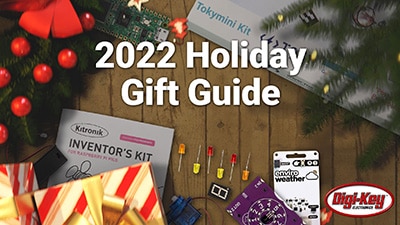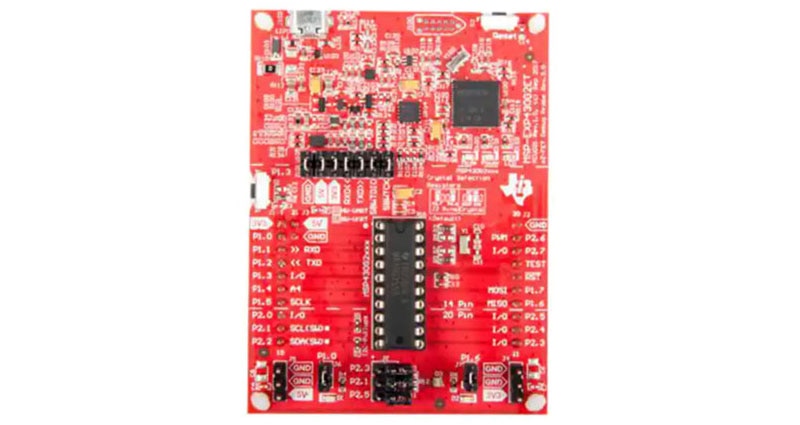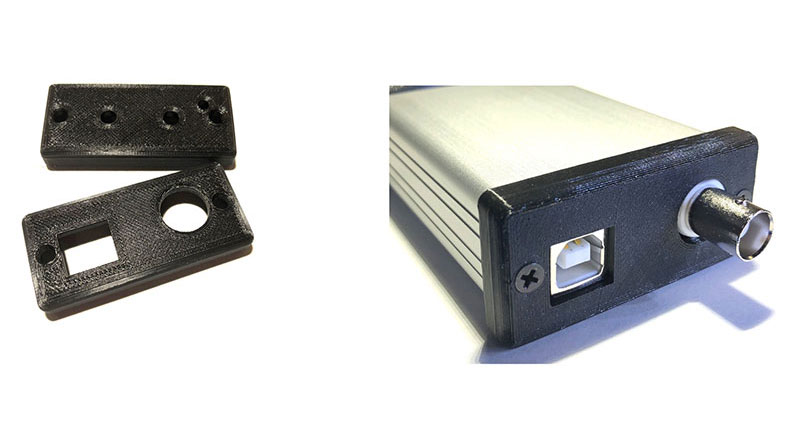Great Holiday Gift Ideas for the Electronics Engineer in Your Life
Electronics engineers love their gadgets. But if your electronics engineer is like me, they’ve probably done their cost-benefit analysis and have purchased only those tools that are the bare necessities to get the job done. But how do you know what they need vs. what they would love to have to make their work easier? Here are a few ideas that might help you find the perfect gift for the electronics engineer in your life.
Specialized tools make prototyping easier
Any devoted electronics design engineer will have several multimeters in their lab. I personally have five (explaining why I have so many is for another blog). A multimeter, as the name implies, allows for the measurement of many electronic characteristics, including voltage (V), current (amperage) (I), resistance (R), capacitance (C), and in some cases, temperature (T).
Most multimeters are quite accurate when it comes to voltage and current but can be lacking in accuracy and resolution when measuring capacitance and resistance. Inductance (L) is a measurement that is not typically a feature found on a multimeter. LCR meters provide accurate measurements of inductance, capacitance, and resistance beyond that of most multimeters. Meters like the B&K Precision model 878B also provide the ability to measure components at different frequencies, again, something lacking in most multimeters (Figure 1). A good LCR meter can provide your engineer with a tool they can’t imagine living without.
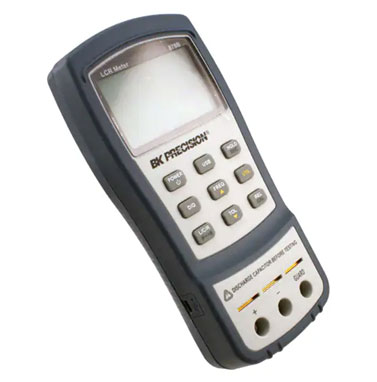 Figure 1: The 878B accurately measures inductance, resistance, and capacitance at different frequencies. (Image source: B&K Precision Corporation)
Figure 1: The 878B accurately measures inductance, resistance, and capacitance at different frequencies. (Image source: B&K Precision Corporation)
When in design mode, working on prototypes, or trying to troubleshoot a broken product, I used to spend significant time searching my parts bin for various resistors and capacitors. Now, thanks to decade boxes from REED Instruments, like the R5408 for resistance and the R5406 for capacitance (Figure 2), I can test a circuit with standard values of resistance and capacitance by merely flipping a few switches. This ability to quickly “dial in” whatever values are needed for resistance and/or capacitance for the circuit under test is invaluable.
These REED decade boxes also provide a grounding terminal to isolate the resistance or capacitance from the circuit, a nice safety feature.
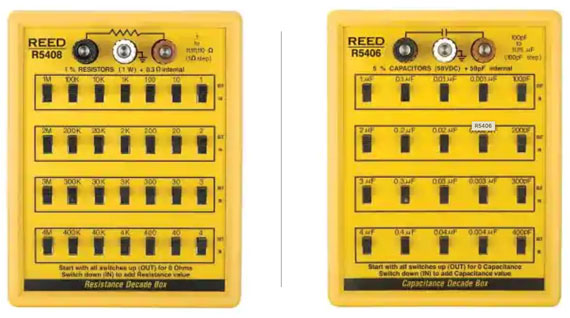 Figure 2: The R5408 decade resistance box (left) and R5406 decade capacitance box (right) provide standard values of resistance and capacitance you can simply dial in. (Image source: REED Instruments)
Figure 2: The R5408 decade resistance box (left) and R5406 decade capacitance box (right) provide standard values of resistance and capacitance you can simply dial in. (Image source: REED Instruments)
Magnification is a must
As the components I work on get smaller and I get older, magnification of my work has become a requirement. I am often working with parts smaller than a millimeter, and I find that I’m reaching for my headband magnifier—like the OPTIVISOR from Aven Tools shown in Figure 3—as soon as I get into my lab. There are multiple magnifications available, as well as lighted versions to help direct light onto the work at hand. If your engineer is over 40 (or, in my case, well over 40!), they’ll appreciate their newfound vision.
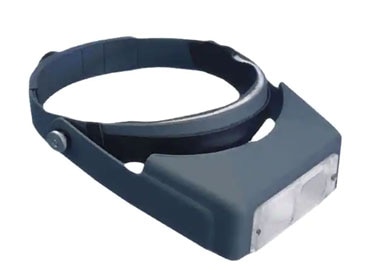 Figure 3: The OPTIVISOR 2-1/2X headband magnifier is a must-have as parts get smaller and eyes get older. (Image source: Aven Tools)
Figure 3: The OPTIVISOR 2-1/2X headband magnifier is a must-have as parts get smaller and eyes get older. (Image source: Aven Tools)
When I need to troubleshoot the solder joints on the pins for those sub-millimeter parts, I need even more magnification from a binocular (or trinocular) microscope like the Aven Tools SPZV50-209-550-PCL (Figure 4). Without my microscope, I’d never be able to troubleshoot the products and prototypes that I produce.
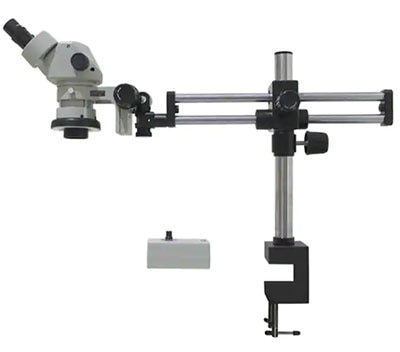 Figure 4: The SPZV50-209-550-PCL articulating trinocular microscope with ring light allows for stereoscopic viewing of components, with a third viewing port for a camera to view work on a nearby display or to take photos. (Image source: Aven Tools)
Figure 4: The SPZV50-209-550-PCL articulating trinocular microscope with ring light allows for stereoscopic viewing of components, with a third viewing port for a camera to view work on a nearby display or to take photos. (Image source: Aven Tools)
Binocular microscopes allow for stereoscopic viewing of components, and a trinocular microscope adds a third viewing port for a digital camera for viewing work on a computer. These tools are essential for anyone trying to troubleshoot today’s microscopic components.
In my experience, I’ve found the articulating arm capability to be extremely useful. It allows me to move my scope to my work rather than risk jostling parts by moving my work to the scope. Important sidenote; if you do purchase a microscope, make sure to get a ring light to illuminate the work being viewed. If you really want to see your engineer jump for joy, a microscope might be just the ticket.
Tweezers help move miniature parts
One final idea. While magnification tools like those mentioned solve the viewing problem, the challenge of moving all those sub-millimeter components around on a printed circuit board (pc board) persists. A good set of tweezers like Aven Tools’ 18800BTK Blutek set can be invaluable here (Figure 5). Various tip sizes and angles make it useful for just about any circumstance.
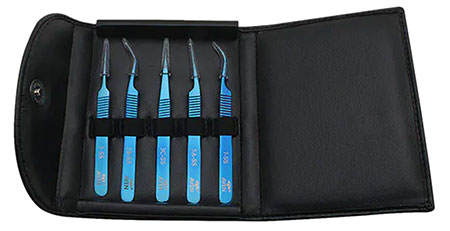 Figure 5: The 18800BTK Blutek tweezer set has a variety of tip sizes and angles to help move sub-millimeter parts around on a board. (Image source: Aven Tools)
Figure 5: The 18800BTK Blutek tweezer set has a variety of tip sizes and angles to help move sub-millimeter parts around on a board. (Image source: Aven Tools)
Conclusion
If the electronics engineer in your life is like me, they’ve probably outfitted their lab with the bare necessity of tools but have been reluctant to fill in the gaps with tools that can really make design and troubleshooting a lot easier. Go ahead and get them something they’ll wish they had acquired a long time ago!

Have questions or comments? Continue the conversation on TechForum, DigiKey's online community and technical resource.
Visit TechForum







